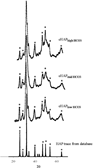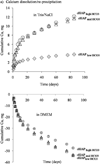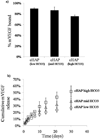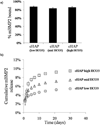Controllable mineral coatings on PCL scaffolds as carriers for growth factor release
- PMID: 22014948
- PMCID: PMC3210399
- DOI: 10.1016/j.biomaterials.2011.09.095
Controllable mineral coatings on PCL scaffolds as carriers for growth factor release
Abstract
In this study, we have developed mineral coatings on polycaprolactone scaffolds to serve as templates for growth factor binding and release. Mineral coatings were formed using a biomimetic approach that consisted in the incubation of scaffolds in modified simulated body fluids (mSBF). To modulate the properties of the mineral coating, which we hypothesized would dictate growth factor release, we used carbonate (HCO(3)) concentration in mSBF of 4.2 mm, 25 mm, and 100 mm. Analysis of the mineral coatings formed using scanning electron microscopy indicated growth of a continuous layer of mineral with different morphologies. X-ray diffraction analysis showed peaks associated with hydroxyapatite, the major inorganic constituent of human bone tissue in coatings formed in all HCO(3) concentrations. Mineral coatings with increased HCO(3) substitution showed more rapid dissolution kinetics in an environment deficient in calcium and phosphate but showed re-precipitation in an environment with the aforementioned ions. The mineral coating provided an effective mechanism for growth factor binding and release. Peptide versions of vascular endothelial growth factor (VEGF) and bone morphogenetic protein 2 (BMP2) were bound with efficiencies up to 90% to mineral mineral-coated PCL scaffolds. We also demonstrated sustained release of all growth factors with release kinetics that were strongly dependent in the solubility of the mineral coating.
Copyright © 2011 Elsevier Ltd. All rights reserved.
Figures










Similar articles
-
Use of micro-computed tomography to nondestructively characterize biomineral coatings on solid freeform fabricated poly (L-lactic acid) and poly ((ε-caprolactone) scaffolds in vitro and in vivo.Tissue Eng Part C Methods. 2013 Jul;19(7):507-17. doi: 10.1089/ten.TEC.2012.0495. Epub 2013 Mar 11. Tissue Eng Part C Methods. 2013. PMID: 23134479 Free PMC article.
-
Formation of calcium phosphate coatings within polycaprolactone scaffolds by simple, alkaline phosphatase based method.Mater Sci Eng C Mater Biol Appl. 2019 Mar;96:319-328. doi: 10.1016/j.msec.2018.11.027. Epub 2018 Nov 22. Mater Sci Eng C Mater Biol Appl. 2019. PMID: 30606539
-
Hydroxyapatite/poly(epsilon-caprolactone) composite coatings on hydroxyapatite porous bone scaffold for drug delivery.Biomaterials. 2004 Mar-Apr;25(7-8):1279-87. doi: 10.1016/j.biomaterials.2003.07.003. Biomaterials. 2004. PMID: 14643602
-
The influence hydroxyapatite nanoparticle shape and size on the properties of biphasic calcium phosphate scaffolds coated with hydroxyapatite-PCL composites.Biomaterials. 2010 Jul;31(21):5498-509. doi: 10.1016/j.biomaterials.2010.03.058. Epub 2010 Apr 15. Biomaterials. 2010. PMID: 20398935
-
Polycaprolactone coated porous tricalcium phosphate scaffolds for controlled release of protein for tissue engineering.J Biomed Mater Res B Appl Biomater. 2009 Nov;91(2):831-838. doi: 10.1002/jbm.b.31464. J Biomed Mater Res B Appl Biomater. 2009. PMID: 19572301 Free PMC article.
Cited by
-
rhBMP2 alone does not induce macrophage polarization towards an increased inflammatory response.Mol Immunol. 2020 Jan;117:94-100. doi: 10.1016/j.molimm.2019.10.021. Epub 2019 Nov 20. Mol Immunol. 2020. PMID: 31759326 Free PMC article.
-
Coating with a modular bone morphogenetic peptide promotes healing of a bone-implant gap in an ovine model.PLoS One. 2012;7(11):e50378. doi: 10.1371/journal.pone.0050378. Epub 2012 Nov 21. PLoS One. 2012. PMID: 23185610 Free PMC article.
-
3-D Scaffold Platform for Optimized Non-viral Transfection of Multipotent Stem Cells.J Mater Chem B. 2014 Dec 14;2(46):8186-8193. doi: 10.1039/C4TB00957F. J Mater Chem B. 2014. PMID: 25541592 Free PMC article.
-
Mineral-Coated Microparticles Enhance mRNA-Based Transfection of Human Bone Marrow Cells.Mol Ther Nucleic Acids. 2019 Dec 6;18:455-464. doi: 10.1016/j.omtn.2019.09.004. Epub 2019 Sep 16. Mol Ther Nucleic Acids. 2019. PMID: 31655263 Free PMC article.
-
Controlled multiple growth factor delivery from bone tissue engineering scaffolds via designed affinity.Tissue Eng Part A. 2014 Aug;20(15-16):2077-87. doi: 10.1089/ten.tea.2013.0358. Epub 2013 Dec 18. Tissue Eng Part A. 2014. PMID: 24350567 Free PMC article.
References
-
- Murphy WL, Grorud K, Vanderby R. Healing of bone and connective tissue. In: Wnek G, editor. Encyclopedia of Biomaterials and Biomedical Engineering. Informa HealthcareUSA, Inc.; 2006. pp. 1–14.
-
- Boyne PJ, Marx RE, Nevins M, Triplett G, Lazaro E, Lilly LC, et al. A feasibility study evaluating rhBMP-2/absorbable collagen sponge for maxillary sinus floor augmentation. Int J Periodontics Restorative Dent. 1997;17:11–25. - PubMed
-
- Cochran DL, Jones AA, Lilly LC, Fiorellini JP, Howell H. Evaluation of recombinant human bone morphogenetic protein-2 in oral applications including the use of endosseous implants: 3-year results of a pilot study in humans. J Periodontol. 2000;71:1241–1257. - PubMed
-
- Boden SD, Zdeblick TA, Sandhu HS, Stephen E. The use of rhBMP-2 in interbody fusion cages. Definitive evidence of osteoinduction in humans: a preliminary report. Spine. 2000;25:376–381. - PubMed
-
- Burkus JK, Gornet MF, Dickman CA, Zdeblick TA. Anterior lumbar interbody fusion using rhBMP-2 with tapered interbody cages. J Spinal Disord Tech. 2002;15:337–349. - PubMed
Publication types
MeSH terms
Substances
Grants and funding
LinkOut - more resources
Full Text Sources
Other Literature Sources
Medical

